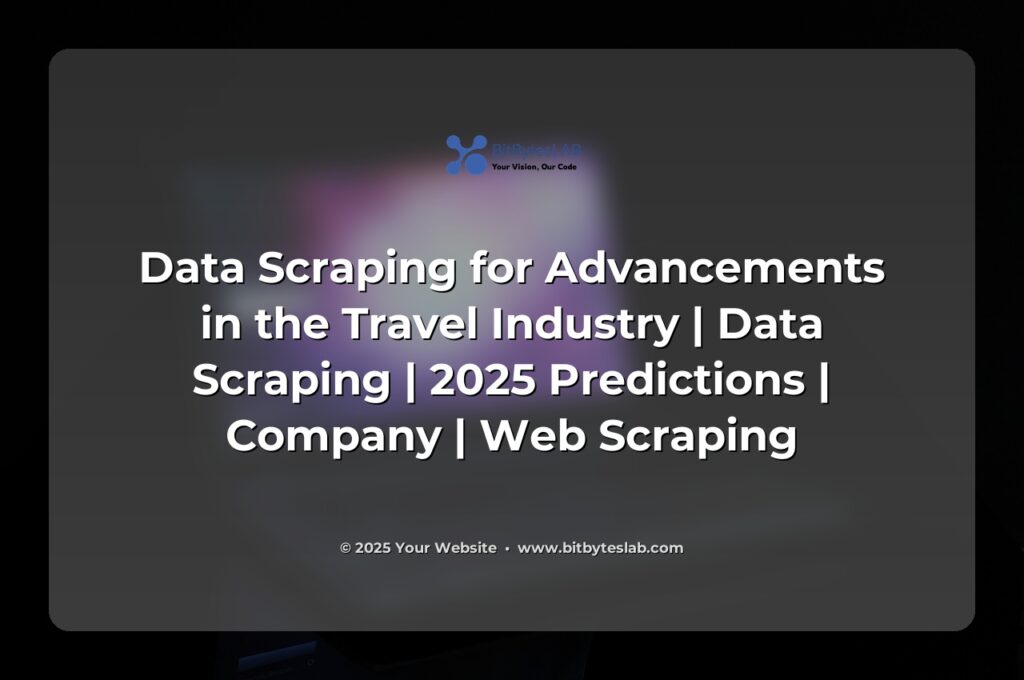Data Scraping for Advancements in the Travel Industry | 2025 Predictions
Picture this: a travel broker in 2025, pulling real‑time flight fares, hotel availability, and customer sentiment all in a single dashboard, all powered by a silent army of scrapers. It’s not a sci‑fi fantasy—it’s the new normal, and it’s reshaping the way airlines, OTAs, and independent agents make decisions.
Every click a traveler makes generates data points—from price drops to seasonal peaks. Yet most of this gold lies behind JavaScript‑rich pages, peppered with anti‑scraping shields, and wrapped in a mix of currencies and date formats. Companies that master the art of cleaning, normalising, and feeding this data into analytics pipelines gain a competitive edge that can’t be replicated by simply buying data from a broker.
In the next few sections, I’ll walk you through the foundational concepts, the practical strategies that keep scrapers running smoothly, and how you can translate raw data into tangible ROI.
Core Concepts & Methodologies
- Data Source – From static HTML to cloud‑hosted APIs, each travel platform offers a different flavor. Knowing whether a site relies on REST, GraphQL, or simply renders data in the DOM is the first puzzle piece.
- Scraping vs. API – When an airline exposes a protected endpoint, you’re forced to mimic a browser. Efficient scrapers treat the page as a living client, not a data lake.
- Headless Browsers – Puppeteer, Playwright, and Selenium let you ride the wave of JavaScript, infinite scrolls, and lazy‑loaded images. They’re the Swiss army knives for dynamic content.
- Politeness & Ethics – Respect
robots.txt, pace yourself, and keep your footprints light; this keeps IP bans at bay and preserves your legal standing. - Data Cleaning & Normalisation – Think of it as the first step in a data warehouse. Dates, currencies, and units must be harmonised to feed downstream models.
- Storage & Schema – Pick between relational SQL for price history, NoSQL for unstructured reviews, or time‑series for trend analysis. Your schema drives query performance.
- Legal & GDPR – In 2025, data harvesting is a gold mine, but it’s also a minefield. Personal data, even if scraped, must be handled with care.
Adopting a modular architecture—dedicated extraction, cleaning, ingestion, and monitoring layers—lets you pivot quickly when a target site re‑writes its API or flips its X‑robots‑tag.
Speaking of pivots, here’s a quick sanity check: Are you already keeping a dashboard that shows the uptime of your scrapers, the latency per domain, and the success rate per endpoint? If not, it’s time to put a dashboard in place. 🚀
Now, a quick laugh to keep the mood light—scraping can be a relentless grind, but we still find humor in the absurdities of programming.
💻 How many programmers does it take to change a light bulb? None, that’s a hardware problem! 💡

Expert Strategies and Approaches
- Incremental Scraping – Only hit pages that have changed. Use
ETagheaders or page timestamps to avoid redundant work. - Stealth Mode – Rotate user‑agents, inject random delays, and use stealth plugins. A polite scraper looks like a human surfer.
- Parallel Scaling – Spin up containerised workers on Kubernetes or serverless functions. Autoscale based on queue depth to match traffic spikes.
- Error Resilience – Exponential back‑off, circuit breakers, and graceful degradation keep your pipeline humming even when a site goes down.
- Data Versioning – Keep snapshots of price history, ratings, and availability. It’s invaluable for auditing and trend analysis.
Let’s not forget that the true power of scraping lies in turning raw numbers into actionable insights. Real‑time price alerts, dynamic packaging recommendations, or predictive delay models—these are the cash‑generating fruits of a well‑engineered scraper.
Industry stats back this up: a 2024 Gartner report found that travel companies using real‑time pricing AI saw a 12% increase in revenue per available room (RevPAR), while dynamic bundle engines boosted conversion rates by 18%. The numbers speak for themselves—scraping is not just a technical necessity; it’s a strategic lever.
Industry Insights and Trends
- AI‑Assisted Extraction – Large Language Models can auto‑generate CSS selectors and map JSON responses to schemas. of it a rapidotyping tool for scrapers.
- Serverless Headless Browsers – Cloudflare Workers and Lambda@Edge now run headless Chrome at the edge, cutting latency and mitigating IP bans.
- GraphQL & WebSocket Leverage – Modern travel sites expose data via GraphQL queries or websockets. A well‑crafted query can fetch entire flight itineraries in a single round‑trip.
- Visual Scraping – Computer vision detects price tags in PDFs or images, unlocking data that was previously inaccessible.
- Compliance‑First Platforms – Data‑as‑a‑Service providers embed GDPR/CCPA compliance, reducing audit overhead.
In practice, the trend is clear: the best players are moving from brittle, hard‑coded crawlers to adaptive, AI‑enhanced pipelines that can automatically adjust to DOM changes or API schema updates.
And now for another good chuckle—because even sophisticated data engineering deserves a break from the grind.
🌐 Why did the web developer leave the restaurant? Because of the table layout! 🍽️

Business Applications and ROI
Scraping is an engine of value when it feeds into three core business functions:
- Dynamic Pricing – Real‑time price feeds let you adjust rates in seconds, capturing peak demand and protecting margins.
- Competitive Intelligence – Automated sentiment analysis of reviews and special offers helps you benchmark against rivals and fine‑tune your own perks.
- Personalised Travel Planning – By correlating user intent with live inventory, you can create hyper‑personalised itineraries that boost conversion and loyalty.
ROI calculations are surprisingly straightforward. If a 15% lift in conversion translates to $3 M in additional revenue per year for a mid‑size OTA, a $200 k investment in a robust scraper—plus maintenance—returns 15× in less than a year.
Common Challenges and Expert Solutions
- CAPTCHAs & Cloudflare – Use stealth headless browsers, rotate proxies, and integrate 2‑captcha solutions.
- JavaScript‑Rendered Content – Capture XHR responses or wait for key selectors using Playwright’s
waitForSelector. - IP Bans / Rate Limiting – Implement exponential back‑off, throttle per domain, and use residential proxies for high‑volume sites.
- Data Quality – Enforce validation and normalization pipelines; treat validation failures as alerts, not silent skips.
- Legal Compliance – Store only non‑PII data; anonymise user reviews; keep a log of consent and data residency.
Remember: a scraper isn’t a one‑time build. It’s a living system that needs continuous monitoring, automated testing, and agile maintenance. Think of it as a fleet of autonomous vehicles—each route may change, but the fleet must keep moving.
Future Trends and Opportunities
Looking beyond 2025, we’re seeing a convergence of AI, edge computing, and regulatory transparency. The next wave will bring:
- Zero‑Touch Scraping – LLMs that automatically generate selectors and adapt to changes without human intervention.
- Edge‑First Architectures – Deploy scrapers in CDN edge nodes to bypass geo‑blocks and reduce latency.
- Embedded Compliance Layers – Tools that auto‑detect and redact PII, ensuring GDPR/CCPA alignment as data flows through pipelines.
- Unified Data Marketplaces – Platforms that allow travel operators to buy and sell curated, live data feeds—reducing duplication and speeding innovation.
In short, the travel industry’s future will be defined by how swiftly and ethically you can turn raw, dispersed data into actionable intelligence. The smarter and lighter your scraper, the faster you can react to price wars, passenger sentiment, and shifting travel trends.
Conclusion
If you’re ready to harness the power of real‑time scraped data, let BitBytesLab help you build a scalable, compliant, and future‑proof pipeline. From architecture design to deployment and ongoing maintenance, we turn complex scraping needs into reliable, data‑driven solutions. ✨





